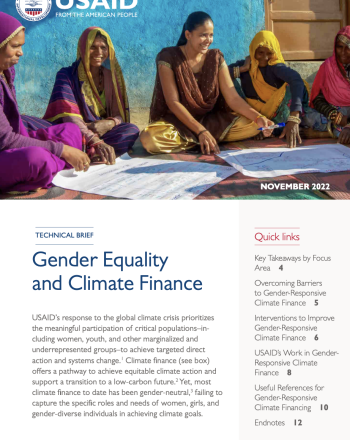USAID’s response to the global climate crisis prioritizes the meaningful participation of critical populations–including women, youth, and other marginalized and underrepresented groups–to achieve targeted direct action and systems change. Climate finance offers a pathway to achieve equitable climate action and support a transition to a low-carbon future. Yet, most climate finance to date has been gender-neutral, failing to capture the specific roles and needs of women, girls, and gender-diverse individuals in achieving climate goals.
Women and girls are disproportionately affected by natural and climate disasters when compared to their male counterparts. Furthermore, research suggests that gender-diverse individuals face increased risk of discrimination due to their gender identity. To ensure equitable climate action outcomes, climate finance must explicitly consider the gendered impacts of climate change and gendered disparities in access to finance.
Examples of gender-responsive climate finance include:
- Providing businesses owned by women and gender-diverse individuals with equitable access to financing for climate adaptation and mitigation investments, for example by offering grants for first-loss capital or tailored loan products;
- Increasing access to climate products or services (e.g., climate-linked insurance), particularly those that disproportionately benefit women, girls, and gender-diverse individuals;
- Providing access to climate mitigation products or services where women and girls are primary stakeholders or beneficiaries (e.g., transitioning from solid or fossil fuels to cleaner household energy sources);
- Investing in climate-impacted sectors—such as agriculture, fisheries, and forestry—where women and girls are primary stakeholders (e.g., beneficiaries, producers);
- Ensuring social safeguards in climate investments that address women, girls, and gender-diverse individuals’ access to decision-making over the use of land resources, equitable benefit sharing, and property rights;
- Investing in climate-impacted or climate-related companies where women constitute at least 30% of senior management or board seats; and
- Investing in climate-impacted or climate-related companies where women and girls constitute at least 30% of employees and the company has committed to reporting on gender equality.


